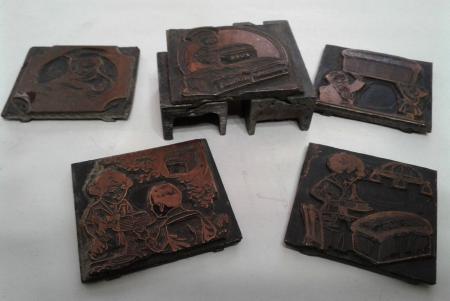Unmounted cuts and backing system
I recently acquired about forty metal cuts for what I’m guessing was a 1920s cookbook. They are unmounted but have two rails/tenons on the back of each. In the same box I eventually found two short sections of mortised “backing strips” that the cuts fit into perfectly. Can anyone tell me more about this system?

cut with rails.jpg

cooking cuts.jpg
I have some similar cuts obtained from a antiques shop in Cleveland. After digging through a pile of these, I found the base, like yours. Couldn’t afford them all so I selected my 3 or 4 favorites and the base. They were advertising cuts. I’ll try to find them and post pictures.
The base apparently was cast on a stripcaster such as an Elrod. Though I’ve never run into anyone that knew anything about the system.
Thanks Arie - I posted this on a letterpress Facebook group as well. From what I’m learning, it seems like it was not very common system - possibly proprietary. These came out of a weekly newspaper office in Ontario. I’m now wondering if these were cuts provided to go along with a syndicated column. (They’re alI one column width) “Handy Household Tips by…” I printed some yesterday. They’re pretty fun.
CAYUGA CUTS 1.jpg
Ian: Can’t find my cuts right now in a very cluttered shop, but I have a few old photos. This one show the face of two of them.
cut3a.jpg
Eureka - My friend Karen, the archivist in Cayuga, Ontario found some of these cuts in their natural habitat - the pages of the “Haldimand Advocate” - from the 1930s. I guess they were part of a stock art set that they used in their advertising.
OLD & YOUNG.png
JARRETT BAKERY.png
Here’s another
OLD & YOUNG.png
About ‘cuts’ generally. Here in the UK and I think the US might be similar, line blocks were mostly etched into zinc and were 18 gauge thick, directly panel pinned to wood mounts. .Hanfltones etched into copper and similarly pinned to wood. Now if you wanted to have say 20 different newspapers to run the ad, you made duplicates by the stereo system, These were backed with molten typemetal and the back planed to 12 points thick. And then pinned to wood. If the subject called for fine halftones, then electo-type shells were made and backed with typemetal to pica plate thickness. And thats what I think youve got there. Consequence was that you needed
two heights of mounting wood or metal in stock for original or for duplicate plates. In the four colour process days the
set of four copper plates were so expensive that in the
best shops, electrotype dups were actually on the machine, the originals kept safe in the office.